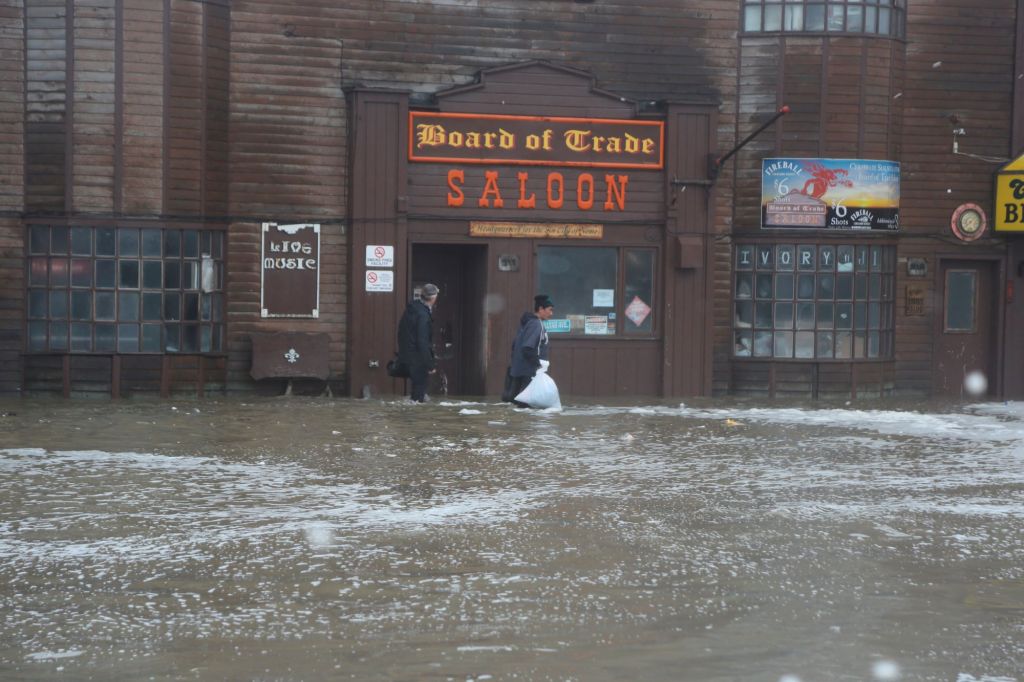Former Typhoon Merbok blasts Alaska with historic storm surge
A historic storm blasted western Alaska Friday and Saturday with hurricane-force winds, over 50-foot seas and coastal flooding not seen in decades.
What used to be Typhoon Merbok morphed into a powerful northern Pacific storm as it raced nearly due north and pushed through the Aleutian Islands Friday and into the Bering Sea Saturday, bringing a dangerous storm surge inundating coastal villages and towns under several feet of water for hours.
Water levels in Unalakleet were over 11 feet Saturday morning and expected to peak at 15 feet later Saturday afternoon, reaching one of the largest peaks on record, according to the National Weather Service.
Major flooding was reported in Golovin where a one-two punch of rain and wind raked the coastal town.
Alaska Governor Mike Dunleavy declared western parts of the state a disaster area on Saturday. The governor said despite the record-breaking impacts the emergency operation center had not received any reports of injuries.
Water is surrounding the school while homes and other structures were flooded. “A couple homes were floating off the foundation,” the National Weather Service in Fairbanks wrote, “and some fuel tanks are tilted over.”
Highest water levels were not expected until Saturday afternoon. Meanwhile, winds there have gusted as high as 62 mph.
The Bering Sea was pushing over berms along Shaktoolik and water was entering the coastal community, getting close to flooding homes. Residents have evacuated to the town’s school and clinic.
In Nome, the forecasted peak surge is 12.45 feet – 9 feet above the high tide line – for later Saturday with waters reaching 5 feet over the high tide level in Red Dog.
Winds reach over 90 mph in spots
The storm surge was pushed by powerful winds circulating the deep storm center, which had reached as low as 937 millibars on its approach to the Aleutian Islands.
Cape Romanzof measured a gust of 91 mph while gusts reached 74 mph on St. Paul Island, and 62 mph in Adak and Golovin.
Offshore, the storm triggered monster seas in excess of 50 feet. A buoy 310 miles north of Adak reported wave heights of nearly 52 feet late Friday morning amid 74 mph wind gusts.
“Even though it is not officially a typhoon – which is what we could call a hurricane in the (U.S.) – it still has all of that powerful energy,” said FOX Weather meteorologist Britta Merwin. “With strong winds, you’re pushing in a lot of water, and that means the sea levels (are) going to rise and coastal flooding is a concern as well as storm surge.”
What’s worse, as the storm slows on its exit toward the Arctic, high water levels will continue for 10 to 14 hours, allowing wind-driven waves on top of the surge to push far inland and produce additional damage.
“Impacts may exceed the 2011 Bering Sea Superstorm, and some locations may experience their worst coastal flooding in nearly 50 years,” National Weather Service forecasters in Fairbanks wrote early Friday morning.
“The storm is massive,” Merwin said. “It’s still holding on to all those characteristics from when it was a typhoon, but now it’s a cold-core system – a non-tropical storm – that’s going to blast Alaska with some very strong winds.”
Intense storm systems are common for Alaska, but seeing an extra-tropical cyclone with a pressure of less than 940 millibars is not frequent. The latest surface analysis as of 8 a.m. ET estimated the storm’s central pressure at 937 mb which is the deepest low for September in at least the last 17 years measured in the region.
“It’s definitely going to be a significant event. It’s shaping up to be one of the worst events that we’ve seen for years,” the National Weather Service office in Fairbanks, Alaska, said.
Threatened region contributes $5 billion to Alaska’s economy
Communities such as Adak, Unalaska, St. Paul, St. Johns and Bethel will all be near the center of the storm, where winds and rains will be the heaviest.
“For most of those Alaskan communities, when a storm is bearing down, they don’t have the capability for evacuations. So, what they normally do is they’ll go to a community shelter, which is the safe option,” said Jeremy Zidek, public information officer at Alaska’s Division of Homeland Security and Emergency Management. “Supply chain issues, transportation issues and weather issues are kind of a regular occurrence, so people have to be pretty resilient to even live in those areas.”

Meteorologists and first responders are most concerned about the maritime community, which produces most of the nation’s seafood.
Pacific salmon, crab, Pacific cod, shrimp, herring, sablefish pollock, and Pacific halibut are all harvested from Alaska and lead to more than $5 billion in economic activity in Alaska every year.
Fomer Typhoon Merbok to have affect on U.S. weather
Typhoon Merbok is one of several significant storm systems from the West Pacific that are expected to get caught up in the jet stream and impact U.S. weather.
Abnormally warm water in the North Pacific is one of the ingredients helping to enhance the lifecycle and strength of the northern cyclones but not enough to help them sustain their tropical cyclone identity into the northern latitudes.
Similar to the Atlantic basin, the Northwest Pacific typhoon season is running behind normal, only seeing about half the storms that they are used to seeing by mid-September.
During recent weeks, the West Pacific has seen an uptick in activity with typhoons Muifa, Hinnamnor and Merbok.
Most, if not all, will lead to impacts in Alaska with rain, wind and high seas, meaning that the 49th state might be in store for a rainy time period.
Experts with the NWS’ Climate Prediction Center expect several weeks of above-average rainfall in the state.
Read the full article Here


